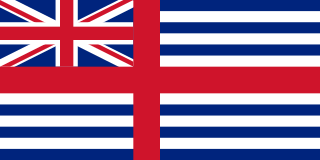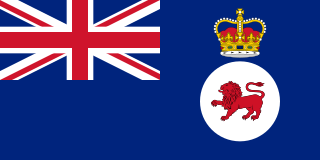
Abel Janszoon Tasman was a Dutch seafarer, explorer, and merchant, best known for his voyages of 1642 and 1644 in the service of the Dutch East India Company (VOC). He was the first known European explorer to reach New Zealand and the islands of Fiji and Van Diemen's Land.

Tasmania is an island state of Australia. It is located 240 km (150 mi) to the south of the Australian mainland, separated from it by Bass Strait. The state encompasses the main island of Tasmania, the 26th-largest island in the world, and the surrounding 1000 islands. It is Australia's least populated state, with 541,965 residents as of March 2021. The state capital and largest city is Hobart, with around 40 percent of the population living in the Greater Hobart area.

Van Diemen's Land was the original name of the island of Tasmania during the European exploration of Australia in the 19th century. A British settlement was established in Van Diemen's Land in 1803 before it became a separate colony in 1825. Its penal colonies became notorious destinations for the transportation of convicts due to the harsh environment, isolation and reputation for being inescapable. Macquarie Harbour and Port Arthur are among the most well-known penal settlements on the island.

The current state flag of Tasmania was officially adopted following a proclamation by Tasmanian colonial Governor Sir Frederick Weld on 25 September 1876, and was first published in the Tasmanian Gazette the same day. The governor's proclamation here were three official flags, they being the Governor's flag, the Tasmania Government vessel flag, and a Tasmania merchant flag. Up until 1856 when Tasmania was granted responsible self-government, the Union flag and the British ensign were primarily used on state occasions.

Anthony van Diemen was a Dutch colonial governor.

The Governor of Tasmania is the representative in the Australian state of Tasmania of Elizabeth II as the Queen of Australia. The incumbent governor is Barbara Baker, who was appointed in June 2021. The official residence of the governor is Government House located at the Queens Domain in Hobart. As the Sovereign predominantly lives outside Tasmania, the governor's primary task is to perform the sovereign's constitutional duties on their behalf.

Sir George Arthur, 1st Baronet was Lieutenant Governor of British Honduras from 1814 to 1822 and of Van Diemen's Land from 1823 to 1837. The malicious campaign against Aboriginal Tasmanians, known as the Black War, occurred during this term of office. He later served as Lieutenant Governor of Upper Canada from 1838 to 1841, and Governor of Bombay from 1842 to 1846.

Colonel William Paterson, FRS was a Scottish soldier, explorer, Lieutenant Governor and botanist best known for leading early settlement at Port Dalrymple in Tasmania. In 1795, Paterson gave an order that resulted in the massacre of a number of men, women and children, members of the Bediagal tribe.

Jørgen Jørgensen was a Danish adventurer during the Age of Revolution. During the action of 2 March 1808 his ship was captured by the British. In 1809 he sailed to Iceland, declared the country independent from Denmark and pronounced himself its ruler. He intended to found a new republic, following the examples of the United States and the French First Republic. He was also a prolific writer of letters, papers, pamphlets and newspaper articles covering a wide variety of subjects, and for a period was an associate of the famous botanists Joseph Banks and William Jackson Hooker. He left over a hundred written autographs and drawings, most of which are collected in the British Library. Marcus Clarke referred to Jørgensen as "a singularly accomplished fortune wooer—one of the most interesting human comets recorded in history".
Stanley is a town on the north-west coast of Tasmania, Australia. Travelling west, Stanley is the second-last major township on the north-west coast of Tasmania, Smithton being the larger township in the Circular Head municipality.

William Thomas Napier Champ was a soldier and politician who served as the first Premier of Tasmania from 1856 to 1857. He was born in the United Kingdom.

William Sorell was a soldier and third Lieutenant-Governor of Van Diemen's Land.

The Australasian Anti-Transportation League was a body established to oppose penal transportation to Australia. Beginning in Van Diemen's Land (Tasmania) in the late 1840s, it had branches in Adelaide, Melbourne, Sydney, and Canterbury. The Colonial Office abandoned transportation to eastern Australia in 1852.

The Van Diemen's Land Company is a farming corporation in the Australian state of Tasmania. It was founded in 1825 and received a royal charter the same year, and was granted 250,000 acres. (1,000 km2) in northwest Van Diemen's Land in 1826. The company was a group of London merchants who planned a wool growing venture to supply the needs of the British textile industry.
Michael Howe was a British convict who became a notorious bushranger and gang leader in Van Diemen's Land, Australia.

The Colony of Tasmania was a British colony that existed on the island of Tasmania from 1856 until 1901, when it federated together with the five other Australian colonies to form the Commonwealth of Australia. The possibility of the colony was established when the Parliament of the United Kingdom passed the Australian Constitutions Act in 1850, granting the right of legislative power to each of the six Australian colonies. The Legislative Council of Van Diemen's Land drafted a new constitution which they passed in 1854, and it was given Royal Assent by Queen Victoria in 1855. Later in that year the Privy Council approved the colony changing its name from "Van Diemen's Land" to "Tasmania", and in 1856, the newly elected bicameral parliament of Tasmania sat for the first time, establishing Tasmania as a self-governing colony of the British Empire. Tasmania was often referred to as one of the "most British" colonies of the Empire.

Van Diemen's Land is a 2009 Australian thriller set in 1822 in colonial Tasmania. It follows the story of the infamous Irish convict, Alexander Pearce, played by Oscar Redding and his escape with seven other convicts. The voice-over and some of the dialogue is in Irish.
Robbins Island is a 9,900-hectare (24,000-acre) island located in Bass Strait, lying off the northwest coast of Tasmania, Australia. The island, separated from the Tasmanian mainland by a highly tidal area known as Robbins Passage, lies south to the adjacent Walker Island.
Andrew Bent was a printer, publisher and newspaper proprietor, active in Australia.
Van Diemen's Land is the former name for Tasmania.













